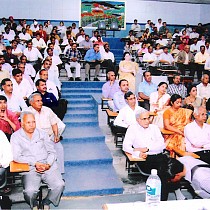SEASONAL INCIDENCE OF PADDY BUG (LEPTOCORISA ACUTA TH.) POPULATION AND ITS MANAGEMENT THROUGH CULTURAL PRACTICES
Department of Zoology, Alipurduar College, Alipurduar, Jalpaiguri - 736122, W.B
KAUSHIK CHAKRABORTY
Assessment on the field dynamics of the paddy bug (Leptocorisa acuta Th.) in relation to paddy crop phenology and climatic parameters was regarded as a prime requisite for the implementation of the adopted crop protection approach in view of modern IPM practices. Field experiments conducted with the widely cultivated high yielding variety Swarna mashuri (MTU 7029) during four consecutive kharif seasons (2004-2007) at Raiganj, Uttar Dinajpur, West Bengal showed paddy bug population was significantly related with maximum temperature, temperature gradient, average temperature, minimum relative humidity and sunshine hour at positive level and with maximum relative humidity and rainfall at negative level. Effect of minimum temperature and rainy days were insignificant. The role of average relative humidity was both positive and negative. Paddy bug rendered maximum and minimum destruction to the kharif crop when transplantation was done at about 27 and 29 standard meteorological week respectively, suggesting the adoption of the latter.


